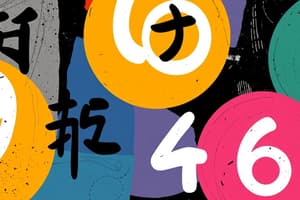Podcast
Questions and Answers
What is the Odaiko and its significance in Japanese culture?
What is the Odaiko and its significance in Japanese culture?
The Odaiko is a big drum that is an integral part of many Japanese festivals (matsuri).
Describe the Koto and its construction.
Describe the Koto and its construction.
The Koto is a 13-string zither made of paulownia wood, approximately two meters long.
What type of performances commonly use the Tsuzumi?
What type of performances commonly use the Tsuzumi?
The Tsuzumi is used in both Noh and Kabuki performances.
What distinguishes the Shamisen from other stringed instruments?
What distinguishes the Shamisen from other stringed instruments?
Identify the Nōkan and its role in Noh performances.
Identify the Nōkan and its role in Noh performances.
What is the Hichiriki and what role does it play in Japanese music?
What is the Hichiriki and what role does it play in Japanese music?
What type of musical instrument is the Sho and where did it originate?
What type of musical instrument is the Sho and where did it originate?
What is the Shinobue and how is it commonly described?
What is the Shinobue and how is it commonly described?
What does the term 'Ryuteki' literally translate to in English?
What does the term 'Ryuteki' literally translate to in English?
In what genre of music is the Hichiriki primarily used?
In what genre of music is the Hichiriki primarily used?
What type of instrument is a Yueqin and what are its main characteristics?
What type of instrument is a Yueqin and what are its main characteristics?
Describe the Pipa and its physical features.
Describe the Pipa and its physical features.
What is the Erhu and why is it significant in Chinese music?
What is the Erhu and why is it significant in Chinese music?
What is the Yunluo, and how is it structured?
What is the Yunluo, and how is it structured?
Explain the Zheng's design and string specifications.
Explain the Zheng's design and string specifications.
What is the Kayagum and how many strings does it have?
What is the Kayagum and how many strings does it have?
Describe the Geomungo and its number of strings.
Describe the Geomungo and its number of strings.
What type of instrument is the Haegum and what is its structure?
What type of instrument is the Haegum and what is its structure?
What materials is the Piri made from and how does it differ from other oboe types?
What materials is the Piri made from and how does it differ from other oboe types?
What is the function of the Changgo in traditional Korean music?
What is the function of the Changgo in traditional Korean music?
Flashcards
Odaiko
Odaiko
A large Japanese drum, often used in festivals.
Tsuzumi
Tsuzumi
An hourglass-shaped drum used in Noh and Kabuki.
Tsuridaiko
Tsuridaiko
A large hanging barrel drum.
Taiko
Taiko
Signup and view all the flashcards
Koto
Koto
Signup and view all the flashcards
Shamisen
Shamisen
Signup and view all the flashcards
Biwa
Biwa
Signup and view all the flashcards
Shakuhachi
Shakuhachi
Signup and view all the flashcards
Nōkan
Nōkan
Signup and view all the flashcards
Hichiriki
Hichiriki
Signup and view all the flashcards
Sho
Sho
Signup and view all the flashcards
Shinobue
Shinobue
Signup and view all the flashcards
Ryuteki
Ryuteki
Signup and view all the flashcards
Yueqin
Yueqin
Signup and view all the flashcards
Pipa
Pipa
Signup and view all the flashcards
Erhu
Erhu
Signup and view all the flashcards
Yunluo
Yunluo
Signup and view all the flashcards
Sheng
Sheng
Signup and view all the flashcards
Dizi
Dizi
Signup and view all the flashcards
Zheng
Zheng
Signup and view all the flashcards
Pengling
Pengling
Signup and view all the flashcards
Kayagum
Kayagum
Signup and view all the flashcards
Geomungo
Geomungo
Signup and view all the flashcards
Haegum
Haegum
Signup and view all the flashcards
Piri
Piri
Signup and view all the flashcards
Changgo
Changgo
Signup and view all the flashcards
Study Notes
Japanese Musical Instruments
-
Odaiko (big drum) - an integral part of many Japanese matsuri (festival).
-
Tsuzumi (hourglass) - used in both noh and kabuki performances.
-
Tsuridaiko - large hanging barrel drum.
-
Taiko - a Japanese drum that comes in various sizes and is used to play a variety of musical genres.
-
Koto - is a 13-string zither, about two meters long and made of paulownia wood.
-
Shamisen - a plucked stringed instrument and its neck is fretless, slimmer than that of guitar or banjo.
-
Biwa - a Japanese short-necked fretted lute, often used in narrative storytelling.
-
Shakuhachi - the most famous flute made from bamboo that has four number of five finger holes on the front face and a thumbhole on the rare face.
-
Nohkan - a parallel bamboo flute and the only melodic instrument used in noh.
Studying That Suits You
Use AI to generate personalized quizzes and flashcards to suit your learning preferences.




